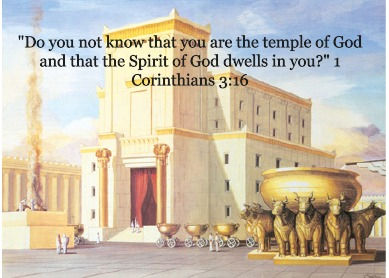The First Temple Foreshadows Believers as God’s Temple
- Carol Plafcan
- Sep 12, 2025
- 7 min read
Why the Old Testament Temple Still Matters Today
What is it about the word, old, that makes people dismiss something as irrelevant? Many of us avoid reading the Old Testament because we don't see its significance to Jesus, nor do we see how it relates to us today (Luke 24:27). But the New Testament without the Old would only be half of the story. The importance of the First Temple is one example. As we will see, the First Temple was a foreshadowing of the temple we read about in the New Testament. You and I are that temple.
The First Temple was more than history. It was a foreshadowing of believers as God’s temple today.
The Construction of Solomon’s Temple
If you've never read about the construction of the First Temple in Jerusalem under King Solomon in about 957 B.C., you should. 2 Chronicles 3:1-5:1 and also 1 Kings 6 and 7 go into vivid detail about every aspect of its construction. To call it grand would be an understatement.
Solomon teaches us some things by constructing this temple. He honored his father's wishes by building it. It was his father's, King David, greatest desire to build a temple to honor God (2 Samuel 7:1-13). But God told him his son would build it, not him (1 Chronicles 28:2-6). Solomon followed through with the plans for the temple his father was given. In Solomon’s time, the First Temple foreshadowed the greater reality that one day believers themselves would be God’s temple.
Lessons from Solomon’s Obedience and Devotion
Solomon’s building of the temple shows us how to follow God’s plan, honor the faith of those before us, diligently carry out our God-given tasks, and work together in His bigger purpose. These lessons teach us to live with humility, faithfulness, and a heart set on doing what God calls us to do.
Solomon was conscientious about the building. This was God's house and, with all the zeal that was within him, he made sure it was constructed of the finest materials and with meticulous detail. When we go about a task for God, how do we treat it? With care or carelessly? Our culture often rushes through tasks or looks for shortcuts. But what would it look like if Christians put the same devotion and excellence into their service, their work, or their relationships as Solomon did in building God’s house?
When we really care about what we do it shows. My husband's mother made a beautiful hand stitched quilt for him out of his father's favorite shirts. The love that went into that showed in every careful stitch and every thoughtful selection of shirts. How much better our lives and those around us would be if we devoted as much effort to the jobs that God has given each of us to do.
Gold, precious stones, and cedars from Lebanon made up its construction. The most sacred place in the temple was the Holy of Holies. Behind its thick veil, one would find the Ark of the Covenant containing the Ten Commandments. Over the Ark were two enormous gold cherubim whose wings were outstretched over it, touching in the middle. The size and beauty of the temple were breathtaking. It took seven years to complete. Where was God in this?
The Glory of the Lord Filling the Temple
At its dedication, the glory of the LORD filled the temple so the priests could not stand to minister (2 Chronicles 5:13–14; 7:1–2). They beheld His glory and knew God was there! And in the Holy of Holies, the priests would come once a year to offer sacrifices for the sins of the people. Compared to the tabernacle described in Exodus, Solomon’s temple was like the difference between a simple shepherd’s hut and a king’s castle.
In the New Testament, believers themselves will be God's living temple.
Maybe you have had a similar experience of awe in the presence of God's creation. Standing at the edge of the Grand Canyon or looking out at the expanse of the ocean we sense our smallness and His greatness. The touch of your child's hand moments after birth, in times like these we can see a glimpse of God's glory reaching out and touching us.
From the Temple Mount to the Cross of Christ
The temple's place on Mt. Moriah in Jerusalem, where Abraham offered Isaac to God only to be replaced with a ram, was significant (Genesis 22). In this event, we see another foreshadowing of the sacrifice of God's Son on the cross. Today we call this place the Temple Mount.
That same presence that filled the Holy of Holies lives in us now through the Holy Spirit. Imagine if we walked into every room with the awareness that the living God was present in us, how would that change our conversations, our tone, even our willingness to forgive?
This magnificent temple was eventually destroyed by the Babylonians when they took the Jews into captivity in 586 BC. Then upon their return the Temple was rebuilt by Zerubbabel. Known as the Second Temple, this temple was where, at age 12, Jesus was in the temple, “sitting among the teachers, listening and asking questions” (Luke 2:41–47). He often taught in the temple courts during His ministry (John 7:14; Matthew 21:12–14). In it, Jesus overthrew the money changer's tables. This temple too would be destroyed in 70 AD by the Romans.
This event was predicted by Jesus. To this day the temple has not been rebuilt. With its destruction the sacrificial system for Jews ended. In its place now sits one of the holiest sites of Islam, the Dome of the Rock. With no physical temple, where is God's glory housed? Just as the First Temple housed God’s glory, Jesus has sent His Comforter to live with us and reflect Him to the world.
The First Temple Foreshadowing Believers as God’s Temple
Paul tells us that our bodies have become the temple of God (1 Corinthians 3:16; 6:19). Paul makes it clear that the First Temple’s foreshadowing finds its fulfillment in us. We don't have to go to a building to realize the presence of God, we just have to look inside ourselves.
How is that? Because as Christians we have received the Holy Spirit of God who lives within us. Just as the power of God could be seen in the Holy of Holies, so others should be able to see His holiness and power in us. If God’s Spirit lives within us, how should that change the way we treat our bodies, our habits, and our daily choices?
Where Jews from all corners would come to worship and sacrifice to God in the first Temple, now we go out to the whole world to show God to those who do not know Him. We are the Jesus others see. We are the love, the light, and the salt that the world desperately needs.
When people encounter us, do they catch even a glimpse of God’s holiness, love, and light dwelling within? This means evangelism isn’t just a program at church; it’s the daily life of the believer. You may be the only ‘temple’ your coworker, neighbor, or family member ever encounters.
The temple was considered so holy that workers were not allowed to use loud tools in its construction. Stones were dressed at the quarry and brought fully finished to the site to be laid. The quiet was a sign of reverence and awe for the One who would dwell there. Our bodies should be treated the same.
We should not disrespect our bodies with sin or overindulgence, by saying or doing things disrespectful to the Holy One who lives in us. In a noisy, self-indulgent world, living with reverence for God in your body is countercultural. The way you eat, rest, speak, and conduct yourself can either honor or dishonor the One who dwells in you. He makes our journey to holiness possible.
Have you ever noticed how people treat their prized possessions? That beautiful new car is washed every week and meticulously cared for. Our favorite coat or dress is worn with care so that nothing stains it, and if something does happen it is immediately cleaned. Why don't we treat our bodies with that kind of care? It should be valued because it houses the Holy Spirit. It is a beautiful temple, a gift of God, created by our Father.
From Earthly Temples to the New Jerusalem
No physical temple is needed because Jesus made the ultimate sacrifice. With His sacrifice, we actually become part of a royal priesthood (1 Peter 2:9) and Jesus becomes our Great High Priest (Hebrews 4:14). He is our mediator between God and man. We no longer have to go through another person to enter into relationship with Him. Through Him we can boldly receive mercy before God.
When John 1:14 says that "the Word became flesh and dwelt among us" this phrase literally means that Jesus tabernacled or pitched his tent with us (Exodus 25:8). By becoming a man, Jesus Himself is a temple, living among men. By sending the Holy Spirit, now God doesn't just dwell with us, but He dwells in us.
Eventually we are told in Revelation 21 that God will dwell with us in the New Jerusalem, fulfilling the First Temple’s purpose. The whole earth will be full of His knowledge and glory (Habakkuk 2:14). We will return to the days of the Garden of Eden before Adam and Eve sinned and ruined this earth with its consequences.
There will be no need for a physical temple because God’s presence will be fully realized. Knowing our future is secure with Him should make us rethink our here and now. If God’s glory will one day fill the earth, shouldn’t we be practicing now what it means to live as His holy dwelling?
From the First Temple’s foreshadowing to the New Jerusalem, the story is one of God’s desire to dwell with His people and now, within us as His holy temple.





Comments